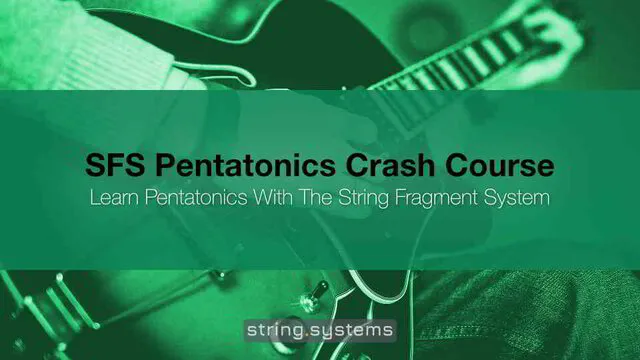How to play melodically everywhere on the guitar
SFS Pentatonics Crash Course 2.0
🎁 Sign up for FREE for the complete mini-course:
🎥 Video Transcript:
Hey friends,
This is Prokopis from string systems, and today we’ll look at how the String Fragment System™ helps you break out of the classic pentatonic box shapes and move freely on the fretboard. If you like this lesson, you can get the complete mini-course for free.
In this lesson, I’ll show you how to move everywhere on the fretboard and construct a pentatonic scale on the fly, and we’ll do this in a way that helps you control your soloing by ear.
We’ll cover 3 points which may seem elusive to many players, but with SFS they actually become very easy:
1. How to play by ear and be melodic in your soloing
2. How to jump around and improvise freely on the fretboard
3. The 3-string shortcut to fast navigation
How to play by ear and be melodic in your soloing
When you memorize a big scale shape, a pentatonic box, you have no practical way to know how the notes in it will sound.
With SFS we start with the Root Note. Just a single note instead of a whole scale shape. And we already know how the root note sounds. We know it’s home base. It’s the most stable-sounding note. Here’s an example in the key of A [example in the video].
So I can go to any A on the fretboard, and I can predict how it will sound. I know the kind of energy it produces. Then, as we gradually add more notes, something wonderful begins to happen:
The fact that we are consistently relating everything to that Root note helps our ear grasp on, and learn the sound of the other notes. For example, the second note on SF1, which will be our first string fragment, has a certain melodic effect in the way it interacts with the root note and the background harmony [example in the video].
So even without doing any ear training lessons and without even learning any theory on scale degrees, you are already starting to predict how that note will sound. While you are improvising this translates into more melodic and creative playing.
And you don’t even need to do this consciously. It just happens as you gradually build the scale shapes note by note using the String Fragment System.
The reality is that the 5 different pentatonic boxes are not really different. They are made of the same notes, which sound the same. SFS helps you focus on that, and allows you to play melodically in all positions, not just the ones you know better.
How to jump around and improvise freely on the fretboard
When you see players moving freely, they usually have a good awareness of the actual notes they are playing, not just box shapes. The good news is that you don’t have to be a computer and think of every single note to do that. In our example of A minor Pentatonic you just need to get fast at locating all the A’s. Those A’s will be our starting points for playing anywhere we want on the fretboard.
If you don’t know the A’s already, you can find a diagram on this lesson page to help you practice them. So an added bonus you get from practicing SFS is that you get to learn the notes on the fretboard in a fun way, which has many many long-term benefits.
But what do you do once you jump to those different A’s? Well, that’s the next part:
The 3 string shortcut to fast navigation
The way I teach SFS in my step-by-step methods is to start with just 1 string fragment and gradually add more while adding improvisation tips and ideas at the same time. But that’s a longer process that cannot fit in a short crash course.
However, there’s a shortcut we can implement right away and that will give you the freedom to jump around immediately and improvise freely, even before you master SFS completely. Let’s just use string fragments 1, 2, and 3 to play one octave of the A minor Pentatonic scale [example in the video].
Now let’s place this 3-string system on every possible A [example in the video].
You’ll notice that there is a one-fret adjustment you need to make whenever the system crosses from the bottom 4 strings into the top two strings [example in the video].
That’s because of the guitar’s tuning, and we discuss that in depth, in another video. But for now, just remember to shift up one fret on the two top strings, and you will be fine. To help you practice this, I’m including a JustPlay practice video that will help you jump between all these options and experience this fretboard freedom first-hand.
In the next lesson get ready for a special ninja technique that will allow you to beat the challenge that is many guitar players’ worse nightmare: Navigating and improvising over Chord Changes!
Until then, enjoy your practice and be effective.



